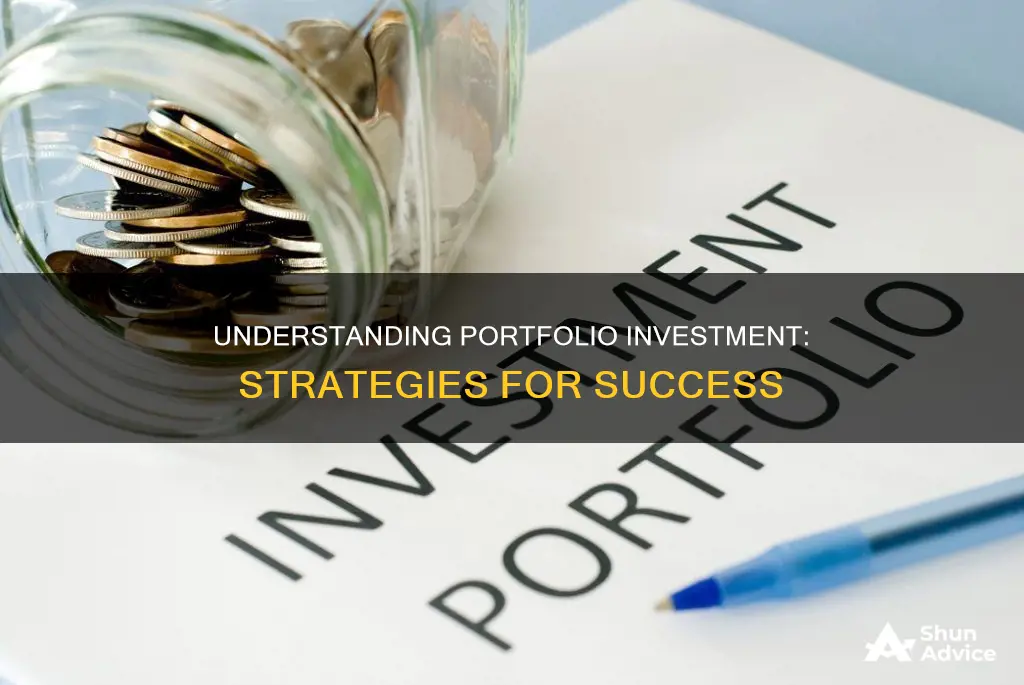
A portfolio investment is a collection of financial investments, such as stocks, bonds, mutual funds, real estate, and commodities. The aim is to diversify risk and generate returns that align with an investor's risk profile. This approach allows investors to balance risk and maximise returns, as different assets perform differently under various economic conditions. Portfolio investments can range from a small segment of an industry to a broad spectrum of the entire market.
| Characteristics | Values |
|---|---|
| Definition | A collection of financial investments |
| Types of Assets | Stocks, bonds, mutual funds, derivatives, bitcoins, real estate, commodities, cash, cash equivalents, exchange-traded funds, art, private investments |
| Investment Style | Passive or hands-off |
| Purpose | Financial gain |
| Involvement | No active participation in the company's internal decision-making |
| Risk | Associated with risk |
| Returns | Expected to earn a return or grow in value over time |
| Management | Actively or passively managed |
What You'll Learn

Passive vs. Direct Investment
Passive vs Direct Investment
Passive and direct investment are two different approaches to investing. Passive investment is a hands-off approach where investors buy assets solely for financial gain without any involvement in the company's internal decision-making. Direct investment, on the other hand, involves making a large investment in a corporation or venture with the aim of controlling and influencing business operations.
Passive investing is more prevalent among retail investors, while active investing has a prominent place in the market. Passive investing is a long-term strategy that involves buying and holding investments with minimal portfolio turnover. It is a cost-effective way to invest as it limits the amount of buying and selling within the portfolio. The primary example of passive investing is buying an index fund that follows a major index like the S&P 500 or Dow Jones Industrial Average. Passive investments have ultra-low fees, good transparency, and are tax-efficient.
Direct investment, also known as active investing, is a hands-on approach that involves buying and selling investments based on their short-term performance, attempting to beat average market returns. Active investing requires a deeper analysis and expertise to know when to pivot into or out of a particular stock, bond, or asset. It provides flexibility, the ability to hedge, and better tax management. However, it is very expensive, with higher fees due to transaction costs and analyst team salaries.
Both passive and direct investment have their advantages and disadvantages, and the choice between the two depends on the investor's financial goals, risk tolerance, and time horizon. Passive investing is generally more suitable for those seeking a long-term, low-cost, and hands-off approach, while direct investment is better for those who want more control over their investments and are willing to put in the time and money to actively manage their portfolio.
Investing vs Saving: Understanding the Key Differences
You may want to see also

Risk-Free Portfolios
While nothing in investing can be 100% guaranteed, the risk associated with these types of investments is so minimal that they are generally considered safe for the average investor. The return on risk-free assets is usually very close to the current interest rate, as their safety means investors don't require higher returns to compensate for the risk.
It's important to note that while the risk of loss is minimal, risk-free portfolios are not entirely devoid of risk. Over the long term, risk-free assets may be subject to reinvestment risk, where the exact rate of return may not be predictable for the entire duration of the investment. Additionally, risk-free assets may not provide protection against a loss in purchasing power due to inflation.
Savings and Investments: Smart Money Strategies for Beginners
You may want to see also

Low-Risk Portfolios
- High-yield savings accounts: These accounts offer a modest return with no risk of losing money. They are government-insured, ensuring that investors are compensated even if the financial institution fails.
- Money market funds: These are pools of low-risk investments, such as CDs and short-term bonds, that are designed to diversify risk. They offer liquidity, allowing investors to withdraw funds without penalties.
- Short-term certificates of deposit (CDs): CDs are FDIC-backed and guarantee a set rate of interest over a specified term. However, withdrawing funds early typically results in a loss of interest and may also incur a penalty on the principal amount.
- Series I savings bonds: These are low-risk bonds issued by the US Department of the Treasury that adjust for inflation. They offer a fixed rate and a variable interest rate that is updated every six months based on the inflation rate.
- Treasury bills, notes, bonds, and TIPS: These are highly liquid securities issued by the US Treasury that can be easily bought and sold. While they carry little risk of losing money if held until maturity, selling them sooner may result in losing a portion of the principal due to fluctuating interest rates.
- Dividend-paying stocks: While stocks are generally riskier than other asset classes, dividend stocks are considered safer than high-growth stocks as they pay cash dividends and tend to be issued by more stable and mature companies.
- Money market accounts: Similar to high-yield savings accounts, money market accounts offer interest payments, liquidity, and FDIC insurance. However, they may require higher minimum deposits and have limits on monthly withdrawals.
It is important to note that even within low-risk investments, there is a sliding scale of risk. Additionally, low-risk portfolios may not be suitable for investors seeking high growth or maximum returns.
Invest Wisely: A Guide to Savings in Australia
You may want to see also

High-Risk Portfolios
The core principle of high-risk investing is the positive correlation between risk and reward. While not always predictable, higher returns are generally associated with higher risk. Thus, investors seeking higher returns must be prepared to accept a higher risk of loss.
It is important to note that not all risks are the same, and some risks are more favourable than others. For example, holding an all-cash portfolio can be risky if inflation erodes its value. Conversely, some stocks may experience wild price swings but still produce good returns. Therefore, investors should focus on taking calculated risks and avoid unnecessary dangers, such as investing in bankrupt companies, which rarely pays off.
- Concentrated portfolios: Investing heavily in a single sector or industry, such as technology stocks or cyclical commodities, can increase risk and return potential. This strategy requires a deep understanding of the industry and its place in the business cycle, as well as a good sense of market psychology.
- Momentum investing: This strategy involves investing in stocks already showing strong price action. The risk lies in the above-average valuations of popular stocks, which can lead to expensive prices. Strong sell discipline is crucial for this strategy, and diversification across sectors can help lower absolute risk.
- Penny stocks: These are stocks that trade at relatively low prices and have low market capitalisation. They are typically not traded on major stock exchanges and are considered high-risk due to their lack of liquidity and susceptibility to large fluctuations from larger investors' activities.
- Emerging technologies: Investing in early-stage technology companies can provide a "ground floor" opportunity. This strategy requires diversification, patience, and a focus on companies with access to capital, as most emerging tech companies fail.
- Currencies, futures, and options: These instruments offer inherent leverage, allowing investors to control a large amount of capital with a small principal. They require agility, patience, and self-confidence. Options, in particular, offer a range of strategies, from low-risk income generation to very high-risk, high-reward plays.
Invest to Grow: Why Smart Investors Shun Savings Accounts
You may want to see also

Diversification Strategies
Diversification is a key part of risk management in portfolio investment. The goal of diversification is to enhance and preserve the value of an investment portfolio.
- Determine correlation: Even if your portfolio contains many different investments, they may all trend up or down together. For instance, high-yield bonds often have a positive correlation with stocks. Therefore, a portfolio made up entirely of high-yield bonds and stocks is not well diversified.
- Diversify across asset classes: There are several asset classes to choose from, including fixed-income investments (bonds), cash and cash equivalents, and real assets (property and commodities). These asset classes have varying levels of risk and returns, so including investments across asset classes will help create a diversified portfolio. Diversified investment portfolios generally contain at least two asset classes.
- Diversify within asset classes: For example, if you invest in energy stocks, consider adding tech, biotech, utility, and retail sectors to your portfolio. For fixed-income investments, look for bonds with different maturities and from different issuers, including the government and corporations.
- Diversify by location: If you only own domestic securities, your entire portfolio is subject to country-specific risk. Foreign stocks and bonds can increase a portfolio's diversification but are subject to additional risks, such as foreign taxation, currency risks, and political and economic developments.
- Explore alternative investments: Assets such as real estate investment trusts (REITs) and commodities can provide additional diversification. REITs are not strongly correlated with stocks or bonds, and commodities such as gold, natural gas, and wheat can act as a hedge against inflation.
- Rebalance your portfolio regularly: Even the most diversified portfolio needs to be rebalanced to maintain the desired asset allocation. Over time, certain investments will gain value, while others will lose it. Rebalancing is a negotiation between risk and reward that can help your portfolio stay on track amid market highs and lows.
- Consider your risk tolerance: Your tolerance for risk can impact your approach to diversification. Aggressive investors with a long time horizon tend to have a higher risk tolerance and allocate more of their portfolio to stocks, while conservative investors with a shorter time horizon may opt for a more balanced mix of stocks and bonds.
Investing More, Saving Less: Surplus Secrets
You may want to see also
Frequently asked questions
A portfolio investment is a collection of financial investments or assets, such as stocks, bonds, commodities, cash, and cash equivalents, including closed-end funds and exchange-traded funds (ETFs). The goal is to diversify and balance risk while maximising returns over time.
Portfolio investments offer a way to customise and diversify an investor's holdings. They provide exposure to various financial instruments, allowing for risk management through diversification. Portfolio investments can also be tailored to an investor's risk tolerance, financial goals, and time horizon.
Building a portfolio investment involves understanding different asset classes, such as stocks, bonds, and real estate. It is important to assess investment goals, risk tolerance, and time horizon. Diversification is key, and regular rebalancing is necessary to maintain the desired asset allocation. Seeking professional advice can also be beneficial.







